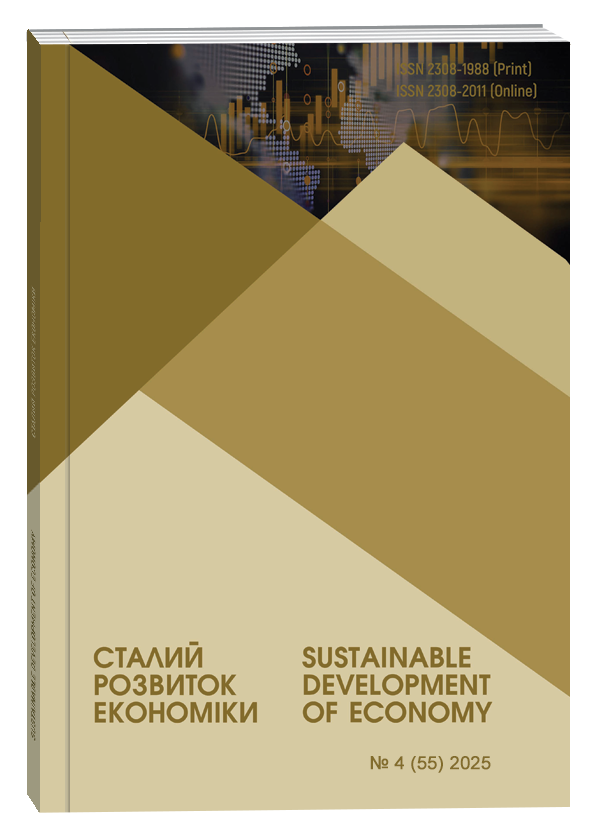TRANSPORT INFRASTRUCTURE AS A FACTOR OF ENHANCING REGIONAL POTENTIAL: FROM CLASSICAL THEORIES TO CONTEMPORARY CHALLENGES
Abstract
This article examines transport infrastructure as a strategic driver for enhancing the regional potential of Ukraine in the context of globalization, digital transformation, post-war reconstruction, and contemporary socio-economic challenges. It explores the evolution of theoretical foundations, ranging from classical location and agglomeration theories to modern concepts of sustainable, endogenous, and network-driven growth, emphasizing the transformation of spatial development paradigms. The analysis reveals the multifaceted impact of transport infrastructure on economic productivity, social cohesion, environmental sustainability, and territorial integration, underscoring its decisive role in strengthening investment attractiveness, facilitating labor mobility, and reducing regional disparities. Particular attention is paid to the “infrastructure dilemma” – the strategic choice between anticipatory (ex-ante) and reactive (ex-post) development models – with a focus on their balanced integration to ensure both long-term competitiveness and short-term responsiveness. The study stresses that effective infrastructure policy must combine macro-level strategic planning with micro-level adaptability, align with principles of economic efficiency and social equity, and incorporate environmental resilience and climate adaptation. In the Ukrainian context, infrastructure is positioned not merely as a supportive facility but as a transformative instrument capable of catalyzing structural change, accelerating European integration, stimulating innovation, and enabling inclusive growth. The paper also highlights the importance of public–private partnerships, state regulation, and international cooperation, showing that alignment with EU strategies such as TEN-T can foster modernization, enhance cross-border connectivity, and integrate national networks into the global transport system. Ultimately, the development of transport infrastructure is presented as both a public good and a strategic resource whose advancement is essential for achieving balanced regional growth, reducing socio-economic asymmetries, and ensuring sustainable, innovation-driven development in the long term.
References
Криворучко О. П. Сутність транспортної інфраструктури України на сучасному етапі. Вісник ХДУ. Серія «Економічні науки». 2019. № 33. С. 25–28.
Жовтяк Г.А. Методичні підходи до визначення поняття транспортної інфраструктури регіону. Економіка та держава. 2010. № 4.
Устименко А. В. Стійкий розвиток транспортної інфраструктури в контексті досягнення Цілей сталого розвитку України. Науковий вісник УжНУ. Серія «Право». 2024. № 85 (3). С. 156-160.
Кудрянцев В. М. Фактори сталого розвитку транспортної інфраструктури. Питання і перспективи розвитку підприємництва. 2022. № 29. С. 42–49.
Смерічевський С., Райчева Л., Михальченко О. Проблеми і перспективи модернізації транспортного комплексу національної економіки. Економіка та суспільство. 2022. № 38. С. 212-218.
Лук’янов В. І. Дослідження умов розвитку транспортної галузі в регіонах України. Бізнес Інформ. 2019. № 12. С. 160–165.
Дмитрієва О. І. Просторова нерівність та галузево-регіональна асиметрія інноваційного розвитку транспортної інфраструктури України. Bulletin of Sumy National Agrarian University. Economics and Management. 2019. № 3. С. 51–58.
Krugman P. Geography and Trade. Cambridge, MA: MIT Press, 1991. 156 p.
Schumpeter J. A. The Theory of Economic Development: An Inquiry into Profits, Capital, Credit, Interest, and the Business Cycle. Cambridge: Harvard University Press, 1934. 255 p.
Schumpeter J. A. Business Cycles: A Theoretical, Historical and Statistical Analysis of the Capitalist Process. New York: McGraw Hill, 1939. 461 p.
Rostow W. W. The Stages of Economic Growth: A Non Communist Manifesto. Cambridge: Cambridge University Press. 1960. 272 p.
North D. C. Structure and Change in Economic History. New York: W. W. Norton & Company. 1981. 240 p.
Aghion P., Howitt P. Endogenous Growth Theory. Cambridge. MA: MIT Press, 2005. 390 p.
Поліський фонд міжнародних та регіональних досліджень. Інфраструктура регіонів України: пріоритети модернізації. Київ : Фонд ім. Ф. Еберта, 2017. 64 с.
Бондар Н. М. Розвиток транспортної інфраструктури України на засадах державно-приватного партнерства. Київ : КНЕУ, 2014. 256 с.
Rosenstein Rodan P. Problems of Industrialisation of Eastern and South Eastern Europe. Economic Journal. 1943. Vol. 53 (210/211). P. 202–211.
Kryvoruchko O. P. (2019) Sutnist transportnoi infrastruktury Ukrainy na suchasnomu etapi [The essence of Ukraine’s transport infrastructure at the present stage]. Visnyk Khersonskoho derzhavnoho universytetu. Seriia “Ekonomichni nauky”, No. 33, Pp. 25–28. (in Ukrainian)
Zhovtiak H. A. (2010) Metodychni pidkhody do vyznachennia poniattia transportnoi infrastruktury rehionu [Methodical approaches to defining the concept of regional transport infrastructure]. Ekonomika ta derzhava, No. 4. (in Ukrainian)
Ustymenko A. V. (2024) Stiiky rozvytok transportnoi infrastruktury v konteksti dosiahnennia Tsilei staloho rozvytku Ukrainy [Sustainable development of transport infrastructure in the context of achieving the Sustainable Development Goals of Ukraine]. Naukovyi visnyk Uzhhorodskoho natsionalnoho universytetu. Seriia “Pravo”, No. 85(3), Pp. 156–160. (in Ukrainian)
Kudriantsev V. M. (2022) Faktory staloho rozvytku transportnoi infrastruktury [Factors of sustainable development of transport infrastructure]. Pytannia i perspektyvy rozvytku pidpryiemnytstva, No. 29, Pp. 42–49. (in Ukrainian)
Smerichevskyi S., Raicheva L., Mykhalchenko O. (2022) Problemy i perspektyvy modernizatsii transportnoho kompleksu natsionalnoi ekonomiky [Problems and prospects of modernization of the transport complex of the national economy]. Ekonomika ta suspilstvo, No. 38, Pp. 212–218. (in Ukrainian)
Lukianov V. I. (2019) Doslidzhennia umov rozvytku transportnoi haluzi v rehionakh Ukrainy [Research on the conditions for the development of the transport sector in the regions of Ukraine]. Biznes Inform, No. 12, Pp. 160–165. (in Ukrainian)
Dmytriieva O. I. (2019) Prostorova nerivnist ta haluzevo-rehionalna asymetriia innovatsiinoho rozvytku transportnoi infrastruktury Ukrainy [Spatial inequality and sectoral-regional asymmetry of innovative development of Ukraine’s transport infrastructure]. Bulletin of Sumy National Agrarian University. Economics and Management, No. 3, Pp. 51–58. (in Ukrainian)
Krugman P. (1991) Geography and Trade. Cambridge, MA: MIT Press, 156 p.
Schumpeter J. A. (1934) The Theory of Economic Development: An Inquiry into Profits, Capital, Credit, Interest, and the Business Cycle. Cambridge: Harvard University Press, 255 p.
Schumpeter J. A. (1939) Business Cycles: A Theoretical, Historical and Statistical Analysis of the Capitalist Process. New York: McGraw Hill, 461 p.
Rostow W. W. (1960) The Stages of Economic Growth: A Non-Communist Manifesto. Cambridge: Cambridge University Press, 272 p.
North D. C. (1981) Structure and Change in Economic History. New York: W. W. Norton & Company, 240 p.
Aghion P., Howitt P. (2005) Endogenous Growth Theory. Cambridge, MA: MIT Press, 390 p.
Poliskyi Fund of International and Regional Studies (2017) Infrastruktura rehioniv Ukrainy: priorytety modernizatsii [Infrastructure of Ukrainian regions: modernization priorities]. Kyiv: Friedrich Ebert Foundation, 64 p. (in Ukrainian)
Bondar N.M. (2014) Rozvytok transportnoi infrastruktury Ukrainy na zasadakh derzhavno-pryvatnoho partnerstva [Development of Ukraine’s transport infrastructure on the basis of public-private partnership]. Kyiv: KNEU, 256 p. (in Ukrainian)
Rosenstein-Rodan P. (1943) Problems of industrialisation of Eastern and South Eastern Europe. Economic Journal, vol. 53(210/211), pp. 202–211.


